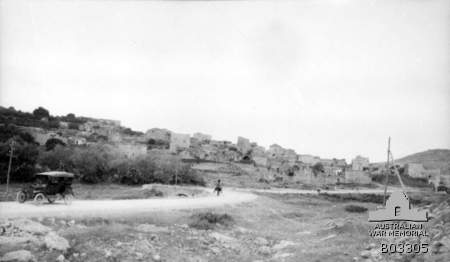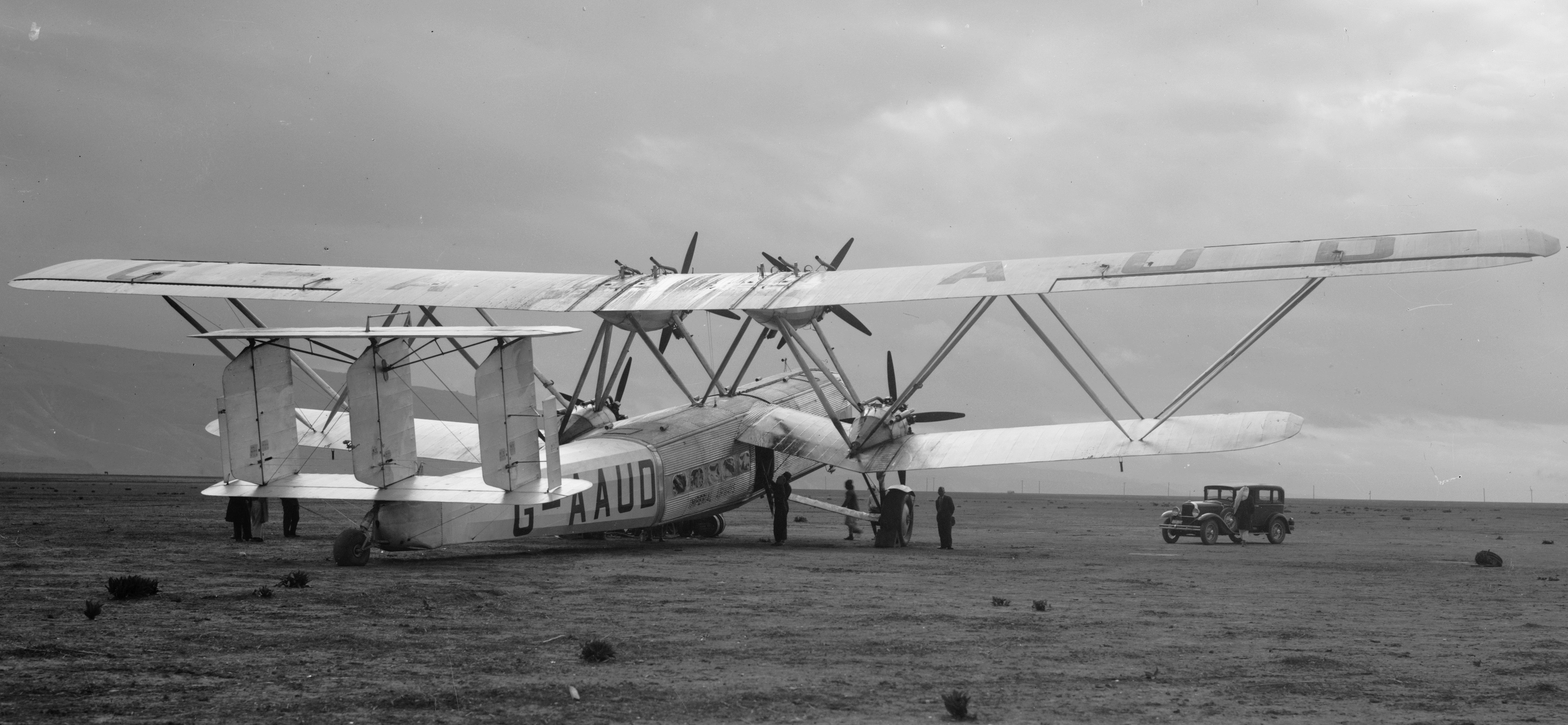|
Capture Of Tiberias
The Capture of Tiberias took place on 25 September 1918 during the Battle of Sharon which together with the Battle of Nablus formed the set piece Battle of Megiddo fought between 19 and 25 September in the last months of the Sinai and Palestine Campaign of the First World War. During the cavalry phase of the Battle of Sharon the Desert Mounted Corps occupied the Esdraelon Plain (also known as the Jezreel Valley and the plain of Armageddon) 40–50 miles (64–80 km) behind the front line in the Judean Hills. One squadron from each of the 3rd and 4th Light Horse Brigades Australian Mounted Division attacked and captured Tiberias (on the western shore of the Sea of Galilee also known as Lake Tiberias), along with the Yildirim Army Group's Ottoman and German garrison. The Tiberias garrison formed part of a rearguard stretching to Samakh and on to Deraa which was intended to cover the retreat of three Ottoman armies. They were set up to delay the advance of the Desert Mount ... [...More Info...] [...Related Items...] OR: [Wikipedia] [Google] [Baidu] |
Middle Eastern Theatre Of World War I
The Middle Eastern theatre of World War I saw action between 30 October 1914 and 30 October 1918. The combatants were, on one side, the Ottoman Empire, with some assistance from the other Central Powers; and on the other side, the British Empire, British (with the help of Nili, a small number of Jews, Greeks, Armenians, some Kurdish tribes and Arab states, along with British Raj, Hindu, Sikh and Muslim colonial troops from India) as well as troops from the British Dominions of Australia, Canada, and New Zealand, the Russian Empire, Russians (with the help of Armenians, Assyrians, and occasionally some Kurdish tribes), and the French Third Republic, French (with its French North Africa, North African and French West Africa, West African Muslim, Christian and Traditional African religions, other colonial troops) from among the Allies of World War I, Allied Powers. There were five main campaigns: the Sinai and Palestine campaign, Sinai and Palestine, Mesopotamian campaign, Mesopo ... [...More Info...] [...Related Items...] OR: [Wikipedia] [Google] [Baidu] |
Jezreel Valley
The Jezreel Valley (from the ), or Marj Ibn Amir (), also known as the Valley of Megiddo, is a large fertile plain and inland valley in the Northern District (Israel), Northern District of Israel. It is bordered to the north by the highlands of the Lower Galilee region, to the south by the Samarian highlands, to the west and northwest by the Mount Carmel range, and to the east by the Jordan Valley (Middle East), Jordan Valley, with Mount Gilboa marking its southern extent. The largest settlement in the valley is the city of Afula, which lies near its center. Name The Jezreel Valley takes its name from the ancient city of Jezreel (city), Jezreel (known in Hebrew as Yizre'el; ; known in Arabic as Zir'in, Zir'ēn, ) which was located on a low hill overlooking the southern edge of the valley. The word ''Jezreel'' comes from the Hebrew, and means "God sows" or "El (god), El sows".Cheyne and Black, ''Encyclopedia Biblica'' The Arabic name of the valley is Marj Bani Amir (), which ... [...More Info...] [...Related Items...] OR: [Wikipedia] [Google] [Baidu] |
Eighth Army (Ottoman Empire)
The Eighth Army of the Ottoman Empire ( Turkish: ''Sekizinci Ordu'') was one of the field armies of the Ottoman Army. It was established during World War I. World War I In June 1917, Enver Paşa activated the Yildirim Army Group (also known as Thunderbolt Army Group) commanded by the German General Erich von Falkenhayn, and reinforced it with surplus Ottoman units transferred from Galicia, Romania, and Thrace.Erickson ''Ordered to Die: A History of the Ottoman Army in the First World War'', Greenwood Press, 2001, , pp. 159, 171, ''Ottoman Army Effectiveness in World War I: a comparative study'' Routledge Press, 2007, p. 115 Following the formation of the Yildirim Army Group substantial forces were deployed to Syria and Palestine, where they continued to hold the Fourth Army defenses. Already in Palestine were the 3rd, 7th, 16th, and 54th Infantry Divisions while the 26th 27th, and 53rd Infantry Divisions arrived during the summer. The 3rd, 7th 16th, and 26th Infantry Div ... [...More Info...] [...Related Items...] OR: [Wikipedia] [Google] [Baidu] |
Seventh Army (Ottoman Empire)
The Ottoman Seventh Army was a large military formation of the Ottoman Empire in the late 19th and early 20th centuries. Although designated as an army, at least by 1918, it was only of corps strength. The Seventh Army was established in 1877 for service in Arabia and the Yemen. By 1908 it consisted of the 13th and 14th infantry divisions, one cavalry regiment and one artillery regiment and they were involved in combatting insurgent tribesmen in the Yemen. World War I Order of Battle, August 1917 In August 1917, the army was structured as follows:Edward J. Erickson, ''Order to Die: A History of the Ottoman Army in the First World War'', Greenwood Press, 2001, , p. 170. *Seventh Army, Syria (Mirliva Mustafa Kemal Pasha) ** III Corps *** 24th Division, 50th Division ** XV Corps *** 19th Division, 20th Division ** German Asia Corps In late 1917, commanded by Fevzi Pasha, the Seventh Army was ordered to advanced across the desert in order to bring pressure to bear upon Alle ... [...More Info...] [...Related Items...] OR: [Wikipedia] [Google] [Baidu] |
Fourth Army (Ottoman Empire)
The Fourth Army of the Ottoman Empire ( Turkish: ''Dördüncü Ordu'') was one of the field armies of the Ottoman Army. It was formed in the middle nineteenth century, during Ottoman military reforms. The army did not survive the WWI battles in Palestine and Syria. Formations Order of Battle, 1877 In 1877, it was stationed in Anatolia. It was composed of:Ian Drury, Illustrated by Raffaele Ruggeri, ''The Russo-Turkish War 1877'', Men-at-Arms 277, Ospray Publishing Ltd., Reprinted 1999, , p. 35. *Infantry: Five line regiments and six rifle battalions *Cavalry: Three line regiments *Artillery: One line regiment (12 batteries) *Engineer: One sapper company Order of Battle, 1908 After the Young Turk Revolution and the establishment of the Second Constitutional Era on 3 July 1908, the new government initiated a major military reform. Army headquarters were modernized. The Fourth Army's new operational area was Caucasia and its many troops were scattered along the frontier to keep ... [...More Info...] [...Related Items...] OR: [Wikipedia] [Google] [Baidu] |
Third Transjordan Attack
The Third Transjordan attack by Chaytor's Force, part of the British Empire's Egyptian Expeditionary Force (EEF), took place between 21 and 25 September 1918, against the Ottoman Empire's Fourth Army and other Yildirim Army Group units. These operations took place during the Battle of Nablus, part of the Battle of Megiddo which began on 19 September in the final months of the Sinai and Palestine campaign of World War I. Fought on the right flank and subsidiary to the Battle of Nablus, the Third Transjordan attack began northwards, with the assault on Kh Fasail. The following day a section of Chaytor's Force, attacked and captured the Ottoman Empire's 53rd Division ( Seventh Army) on the main eastwards line of retreat out of the Judean Hills across the Jordan River. Retreating columns of the Yildirim Army Group were attacked during the battle for the Jisr ed Damieh bridge, and several fords to the south were also captured, closing this line of retreat. Leaving detachments ... [...More Info...] [...Related Items...] OR: [Wikipedia] [Google] [Baidu] |
Battle Of Tabsor
The Battle of Tabsor was fought on 19–20 September 1918 beginning the Battle of Sharon, which along with the Battle of Nablus formed the set piece Battle of Megiddo fought between 19 and 25 September in the last months of the Sinai and Palestine Campaign of the First World War. During the infantry phase of the Battle of Sharon the British Empire 60th Division, XXI Corps attacked and captured the section of the front line nearest the Mediterranean coast under cover of an intense artillery barrage including a creeping barrage and naval gunfire. This Egyptian Expeditionary Force (EEF) victory over the entrenched Ottoman Eighth Army, composed of German and Ottoman soldiers, began the Final Offensive, ultimately resulting in the destruction of the equivalent of one Ottoman army, the retreat of what remained of two others, and the capture of many thousands of prisoners and many miles of territory from the Judean Hills to the border of modern-day Turkey. After the end of the ... [...More Info...] [...Related Items...] OR: [Wikipedia] [Google] [Baidu] |
Battle Of Tulkarm
The Battle of Tulkarm took place on 19 September 1918, beginning of the Battle of Sharon, which along with the Battle of Nablus formed the set piece Battle of Megiddo fought between 19 and 25 September in the last months of the Sinai and Palestine Campaign of the First World War. During the infantry phase of the Battle of Sharon the British Empire 60th Division, XXI Corps attacked and captured the section of the front line nearest the Mediterranean coast under cover of an intense artillery barrage including a creeping barrage and naval gunfire. This Egyptian Expeditionary Force (EEF) victory over the entrenched Ottoman Eighth Army, composed of German and Ottoman soldiers, began the Final Offensive, ultimately resulting in the destruction of the equivalent of one Ottoman army, the retreat of what remained of two others, and the capture of many thousands of prisoners and many miles of territory from the Judean Hills to the border of modern-day Turkey. After the end of the ... [...More Info...] [...Related Items...] OR: [Wikipedia] [Google] [Baidu] |
Egyptian Expeditionary Force
The Egyptian Expeditionary Force (EEF) was a military formation of the British Empire, formed on 10 March 1916 under the command of General Archibald Murray from the Mediterranean Expeditionary Force and the Force in Egypt (1914–1915), at the beginning of the Sinai and Palestine campaign of the First World War. History Formed in the British protectorate of the Sultanate of Egypt, the initially small force was raised to guard the Suez Canal and Egypt. After the withdrawal from the Gallipoli campaign the force grew into a large reserve to provide reinforcements for the Western Front, while the Western Frontier Force fought in the Senussi campaign from 1915 to 1917 and the Eastern Force (EF) defended the canal at the Battle of Romani in August 1916. Following the victory at Romani, part of the Eastern Force pursued the Ottoman invading force back to Palestine after the victories at the Battle of Magdhaba in December 1916 and the Battle of Rafa in January 1917, by which ... [...More Info...] [...Related Items...] OR: [Wikipedia] [Google] [Baidu] |
Deraa
Daraa (, Levantine Arabic: ) is a city in southwestern Syria, north of the border with Jordan. It is the capital of Daraa Governorate in the Hauran region. Located south of Damascus on the Damascus–Amman highway, it serves as a way station for travelers. Nearby localities include Umm al-Mayazen and Nasib to the southeast, al-Naimah to the east, Ataman to the north, al-Yaduda to the northwest and Ramtha, Jordan, to the southwest. According to the Syrian Central Bureau of Statistics, Daraa had a population of 97,969 in the 2004 census. It is the administrative center of a ''nahiya'' (subdistrict) which contained eight localities with a collective population of 146,481 in 2004. By the 3rd century, it had gained the status of polis or self-governed city. The Roman historian Eusebius referred to it. The area east of Adraa was a centre of the Ebionites. Adraa itself was a Christian bishopric. Arabio, the first bishop of Adraa whose name is known, participated in the ... [...More Info...] [...Related Items...] OR: [Wikipedia] [Google] [Baidu] |
Samakh, Tiberias
Samakh () was a Palestinian Arab village at the south end of Lake Tiberias (the Sea of Galilee) in Ottoman Galilee and later Mandatory Palestine (now in Israel). It was the site of battle in 1918 during World War I. In the 19th century, Algerian migrants settled in Samakh, transforming it into one of the largest Algerian concentrations in the district. Between 1905 and 1948, the town was an important stop on the Jezreel Valley railway and Hejaz railway, being the last effective stop in the British Mandate of Palestine (the station at al-Hamma was geographically isolated). It had a population of 3,320 Arab Muslims and Arab Christians in 1945.Appendix B - Non-Jewish Population within the Boundaries Held by the Israel Defence Army on 1.5.49 - as on 1.4.45, in accordance with Government of Palestine, ''Village Statistics, April, 1945'', p7 The town's inhabitants fled after Haganah forces captured the town on 3 March 1948, and the remainder left in the wake of an assault b ... [...More Info...] [...Related Items...] OR: [Wikipedia] [Google] [Baidu] |
German Empire
The German Empire (),; ; World Book, Inc. ''The World Book dictionary, Volume 1''. World Book, Inc., 2003. p. 572. States that Deutsches Reich translates as "German Realm" and was a former official name of Germany. also referred to as Imperial Germany, the Second Reich or simply Germany, was the period of the German Reich; . from the unification of Germany in 1871 until the German revolution of 1918–1919, November Revolution in 1918, when the German Reich changed its form of government from a monarchy to a Weimar Republic, republic. The German Empire consisted of States of the German Empire, 25 states, each with its own nobility: four constituent Monarchy, kingdoms, six Grand duchy, grand duchies, five Duchy, duchies (six before 1876), seven Principality, principalities, three Free imperial city, free Hanseatic League, Hanseatic City-state, cities, and Alsace–Lorraine, one imperial territory. While Prussia was one of four kingdoms in the realm, it contained about two-thirds ... [...More Info...] [...Related Items...] OR: [Wikipedia] [Google] [Baidu] |







